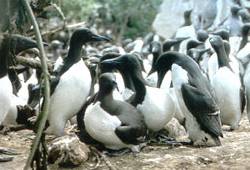Common Guillemot (Uria aalge) - Wiki Common Guillemot
From Wikipedia, the free encyclopedia
[Photo] Common Murres Uria aalge from USGS (http://www.absc.usgs.gov/research/seabird_foragefish/seabirds/flash_cards/common_murre.html). Title: Murres nesting on Duck Island. Source: USGS, Seabirds, Forage Fish, and Marine Ecosystems in Alaska
The Common Guillemot, known as the Common Murre in North America, Uria aalge, is a large alcid. It spends most of its lifetime at sea, only coming to land to breed on rocky cliff shores or islands.
Description
Adult birds are 38-46 cm in length with a 61-73 cm wingspan and weigh 945-1044 g when fully grown. They are black on the head, back and wings, and have white underparts. They have a thin dark pointed bill and a small rounded dark tail. The face becomes white in winter with a dark spur behind the eye. The chicks are downy in appearance with blackish on top and white below.
Western European birds of the race U. a. albionis are dark brown rather than black, most obviously so in colonies in southern Britain. Some individuals in the North Atlantic, known as "Bridled Guillemots", have a white ring around the eye extending back as a white line.
The bird is a fast, agile flier. The wings flap quickly and continuously in a straight line along the sea surface.
Common Guillemots have a variety of calls including a soft purring noise.
oduction and behaviour
Their breeding habitat is islands, rocky shores, cliffs and sea stacks on:
North Atlantic coasts, in North America as far south as New Brunswick, and in Europe as far south as Portugal.
The north Pacific coasts of Alaska and British Columbia down to California. On the Asian side it breeds in Russia and Hokkaid??.
The breeding population is large with over two million pairs. It is stable but threats include hunting (legal in Newfoundland), pollution and oil spills.
They usually nest in tight-packed colonies (known as "loomeries") and lay their eggs on bare rock ledges or ground. The eggs are pointed, so that if disturbed they roll in a circle rather than fall off the ledge. Eggs are laid between May and July for the Atlantic populations and March to July for those in the Pacific. The eggs vary in colour and pattern to help the parents recognize them, each egg is unique. Colours include white, green, blue or brown with spots or speckles in black or lilac. Both parents incubate the egg for 28 to 34 days, swapping in twelve hour shifts.
The chicks will leave the nest after 18 to 25 days. Once the young chicks have left the nest the male teaches them how to dive and catch fish for up to two months. The chicks learn to fly roughly two weeks after fledging. Up until then the male feeds and cares for the chick at sea. In migration the chick swims about 1000 km. Common Guillemots only breed when they reach four to six years old. The lifespan is about 20 years.
Courtship displays including bowing, billing and preening. The male points its head vertically and makes croaking and growling noises to attract the females. The Guillemots are monogamous. The colonies are dense with up to twenty pairs occupying one meter square at peak season. The islands can also be inhabited by other species.
Some birds are permanent residents; northern birds migrate south to open waters near New England, southern California, Japan, Korea and the western Mediterranean.
Feeding
These birds are surface-divers which forage for food by swimming underwater using their wings for propulsion. They mainly eat small schooling fish (max. 200 mm long) such as polar cod, capelin, launces, sprats, sandeels, Atlantic cod and herring. They also eat some molluscs, marine worms, squid and crustaceans such as amphipods. They can consume up to 32 grams of food in a day. Diving depths up to 50 m have been recorded and birds can remain underwater for up to a couple of minutes. They are often seen carrying the fish in their bill with the fishtail hanging out.
http://en.wikipedia.org/wiki/Common_Guillemot
| The text in this page is based on the copyrighted Wikipedia article shown in above URL. It is used under the GNU Free Documentation License. You may redistribute it, verbatim or modified, providing that you comply with the terms of the GFDL. |
